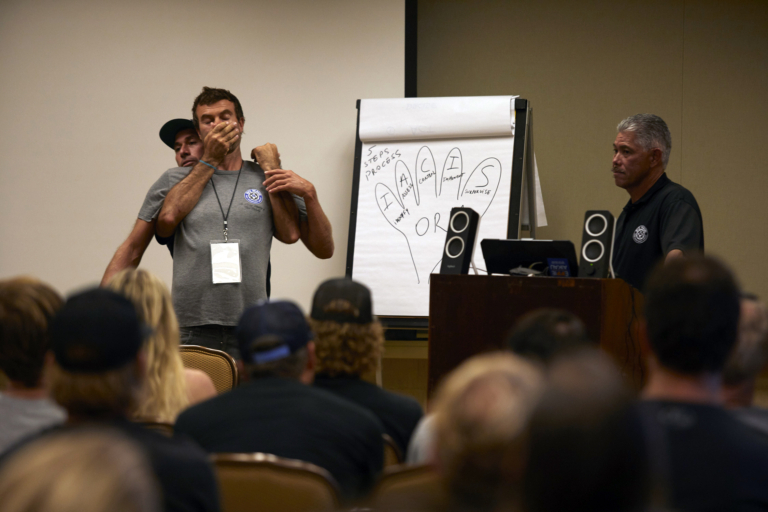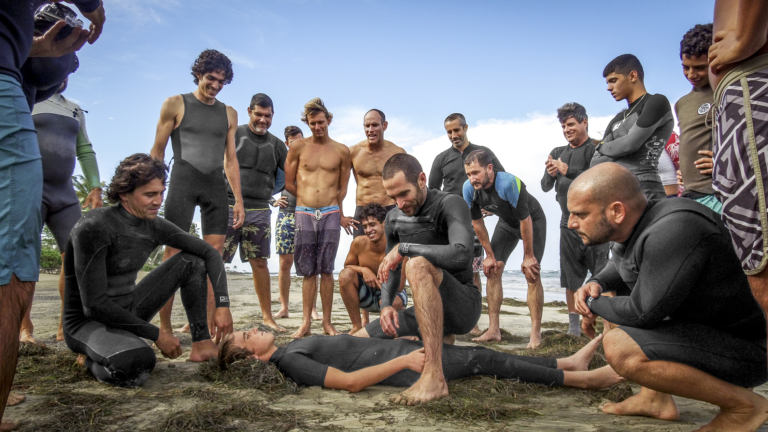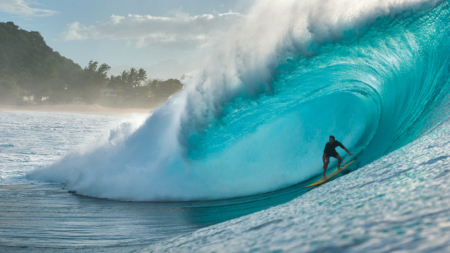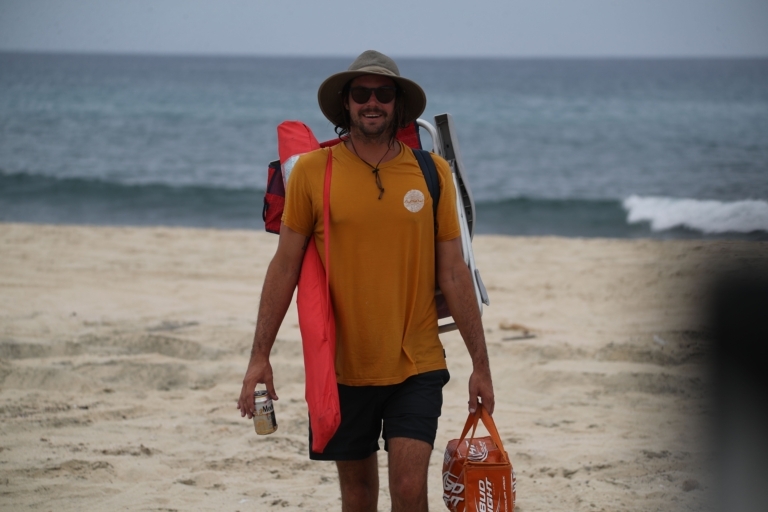Dead Friends and Ocean Risk Management
Kohl Christensen discusses how BWRAG came to be and his recent near-death experience courtesy of Pipeline's reef.
“It sparked something,” cofounder of Big Wave Risk Assessment Group (BWRAG) Kohl Christensen says of his friend Sion Milosky’s death at Mavericks on March 16, 2011. “We thought, ‘Man, this is fucked. One of the guys pushing the sport the hardest just died in front of us.’”
When Christensen’s good friend and BWRAG cofounder Danilo Couto returned to Hawai‘i from that trip to Half Moon Bay, California, it was apparent something had to be done. This wasn’t the first, and it wouldn’t be the last, death in the big wave surfing community, nor was it the first of Couto and Christensen’s friends to die pursuing waves of extra-large stature. “I’ve had friends die before,” says Kohl. “But when they died, sadly, nothing really changed [as far as safety’s concerned]. When Danilo came back from that session, we got together and started BWRAG; it was the fire that started the whole movement.”
In the years leading up to Milosky’s death, big wave surfing was reaching a boiling point. In 2009, the then-ASP Big Wave Tour (now World Surf League) was starting up. With significant XL-swell events aplenty and competition on the rise, the bar of what size waves surfers were paddling into was set higher. The big wave community was split between paddle and tow-in surfing (catching waves using a Jet Ski). The collective consciousness shifted: If you’re a real big wave surfer, you paddle whenever possible.
“At that time, the surfing was advancing faster than the safety systems,” says Christensen. “People were pushing it so hard. None of us were wearing [impact or inflation] vests. It felt like something was going to break; it had for a while.”
So, in 2011, at Christensen’s off-the-grid North Shore farm, a group got together and held a CPR course. “My neighbor’s an ER doc, and he knew Pam Foster, who owns the AED Institute. She came out to my barn and we all did this killer CPR class. That was the beginning of it all, and we said, ‘Let’s organize a summit next year.’ Liam [Wilmott, one of BWRAG’s founders] was working at Turtle Bay at the time, so we had our in at the hotel and got it moving.”
It was the first unofficial BWRAG meeting. Over the next decade, the group grew into an internationally taught course, featuring 14 stops across Australia, Hawai‘i, California, Portugal, Chile, British Columbia and more,* run by some of the world’s best big wave surfers with emergency response training. They teach ocean safety in a digestible two-day course.
“We encourage a large mix of age groups, and we want people to understand the course is not necessarily for advanced or big wave surfers. It’s also for young kids, the parent on the beach, whoever,” says Christensen.

Kohl Christensen at the front of the BWRAG classroom at Turtle Bay. North Shore, Oahu. Photo: Ryan Foley
The course is run by Brian Keaulana, a well-known and thoroughly respected Hawaiian lifeguard. He is also the son of legendary Hawaiian surfer Buffalo Keaulana and the go-to person for maintaining ocean safety on the Hawaiian Islands when Hollywood comes to town. As BWRAG’s chief master instructor, he adapted the course from the military’s risk management program and applied it to the ocean. “It’s been an honor to have him guide and mentor us for the last ten years. Ocean risk management is the meat and potatoes of the course. We teach people how to look for potential hazards at surf spots and beaches, and then we run scenarios: You’re at this break. Sally and Joe both went surfing and got hurt. Sally is unconscious, and Joe has a broken arm. What do you do?”
A lot of the surfers involved with BWRAG have had close calls courtesy of the ocean: Greg Long’s near-drowning at Cortes Bank, Aaron Gold’s near-drowning at Cloudbreak (he was revived by Greg Long), Christensen’s head injury at Pipeline in 2019, to name a few. And the close calls they’ve navigated their fellow surfers through are innumerable. It comes with the territory.
“A lot of people come into the course really excited about holding their breath as long as possible,” says Christensen, when asked about expectations of BWRAG versus reality. “We don’t specialize in that, but we do have a mindful breathing course taught by Greg [Long]. People think holding their breath longer will help them surf bigger waves, but a lot of people walk away with a whole different set of skills than they imagined they’d have after taking the course.
“The way we teach CPR is easy to digest and fun,” Christensen continues. “A lot of people want to learn Jet Ski rescues, so we demonstrate proper pickups for conscious and unconscious victims. We train everyone on how to get picked up by a Ski, with and without a surfboard. We offer advanced courses for those who want to learn more about Jet Ski rescues, but in the normal course, we don’t have time to put everyone on the Skis.”
Christensen explains that other than junior lifeguard and lifeguard programs, there really aren’t many courses like BWRAG that focus on ocean safety and risk management. Whereas in the mountains, safety is well established, and courses are easily accessible to anyone willing to learn. “Most people haven’t worked as lifeguards or had the chance to do junior guards,” he says. “I’ve taken several avalanche courses. There are more deaths due to avalanches than surfing, so the safety precautions and available training in the mountains are more advanced.”
In the past decade, safety has become a top concern for people visiting mountain resorts to ski or snowboard. Ten years ago, wearing a helmet wasn’t as common and was considered a little dorky, but now it’s rare to see someone riding down the mountain sans safety equipment.
Surfing is slower to conform for a lot of reasons, ego being number one. “The first time I saw somebody wearing flotation was at one of the outer reefs [on Oahu]. We laughed at it,” Christensen says. “It looked like a muscleman suit. We were like, ‘Woah, look at this guy, he needs to wear this thing to surf out here?’ There was the same reaction to the leash when that first appeared. Now everyone wears a leash.”

Master Instructor Greg Long and Patagonia’s wetsuit researcher and product developer Andrew Reinhart run scenario training in Oahu. Photo: Tony Dooley
Today, however, there’s a shift in cognizance. In the big wave and wave of consequence community, the helmet is becoming more popular, and flotation and impact vests are becoming standard practice, although it’s catching on slowly. Just this past year, Christensen was surfing at Pipeline—a wave he’s surfed on its heaviest days for the past two decades-plus—when he hit his head on the reef, knocking him unconscious.
“The only reason I’m still here is because I got rescued. It was gnarly,” he says. “The night before, I had missed a couple pretty throaty ones, and I was hungry. It was big, solid Pipe. A deep set came in; it was a little warm-up, nothing special. I pulled in and it [the wave] ran off, so I figured I’d just die with it in the tube. Not literally, though—” Christensen laughs, albeit darkly. “Then, boom! Right to the reef. The next thing I remember, I was lying on the backboard with an oxygen mask on, looking up at the lifeguards.”
At the time of Christensen’s injury, there were four Jet Skis in the channel. He was saved by fellow surfers and lifeguards with emergency response training (a lot of the same skills taught in the BWRAG courses) and largely due to the built-in flotation on the Patagonia impact vest he wore. “There are never four skis in the channel,” he says. “Andrew Logreco [North Shore lifeguard], who came over from Waimea because he had a feeling he needed to be at Pipeline, grabbed me. I was floating facedown. When he flipped me over, he said I took a huge breath; then Kai Borg [North Shore surfer and Pipeline staple], who happened to be out there with Jimmy Stuart, came and helped out. All those guys know how to do rescues. Kai grabbed Andrew and me and pulled us into shore. The lifeguards packaged me up and sent me straight to Queens Hospital.” Christensen suffered a fractured skull and was rushed into surgery. “I could’ve easily had a different result. I’m so lucky.”
Christensen made a full recovery and was able to get back in the water last April. He’s surfed a few of the outer reefs on bigger days but hasn’t made it back to Pipeline. “Strangely, getting wacked in the head has been the best thing that’s ever happened to me. It’s allowed me to finally see what’s really important. I’ve just been hanging out with my wife and two little girls, enjoying life,” he says.
Coming into winter on the North Shore, Christensen grapples with his return to Pipeline. “I’ve been involved with Pipeline for over 20 years. I’ve had friends die out there, a lot of friends get injured. The further away I get from the accident, the more comfortable I feel in the ocean, but I don’t want to put my wife and kids through that again. The easy thing to do would be never surf Pipe again, but then who would I be without that in my life? I currently feel like I could surf Pipeline and I’d wear a helmet and an impact vest. I’d like to get another big barrel out there. The best I can do is implement some controls. The ocean’s dynamic. I can’t control everything that happens out there, but I can minimize the risk.”
*Shutdown by COVID-19 in 2020, an online course is being released in place of in-person classes; presale registration is available here.

